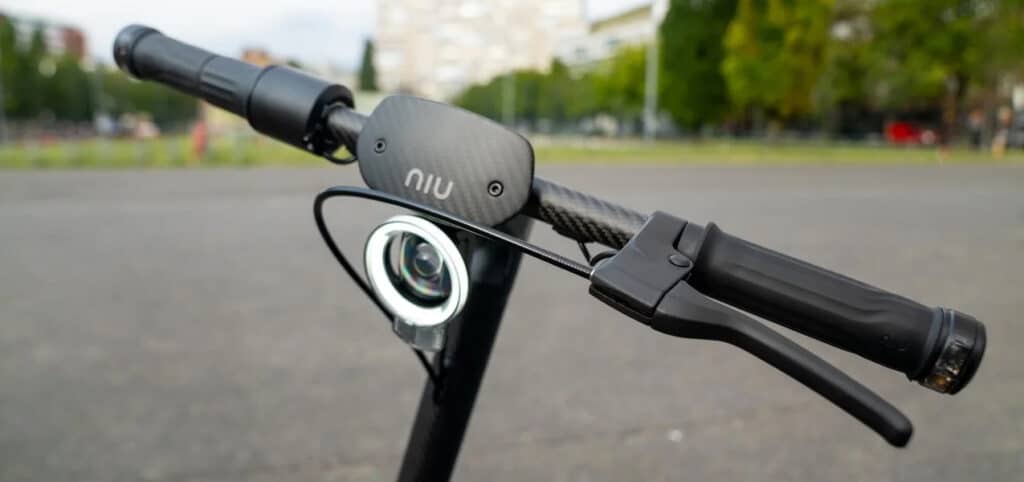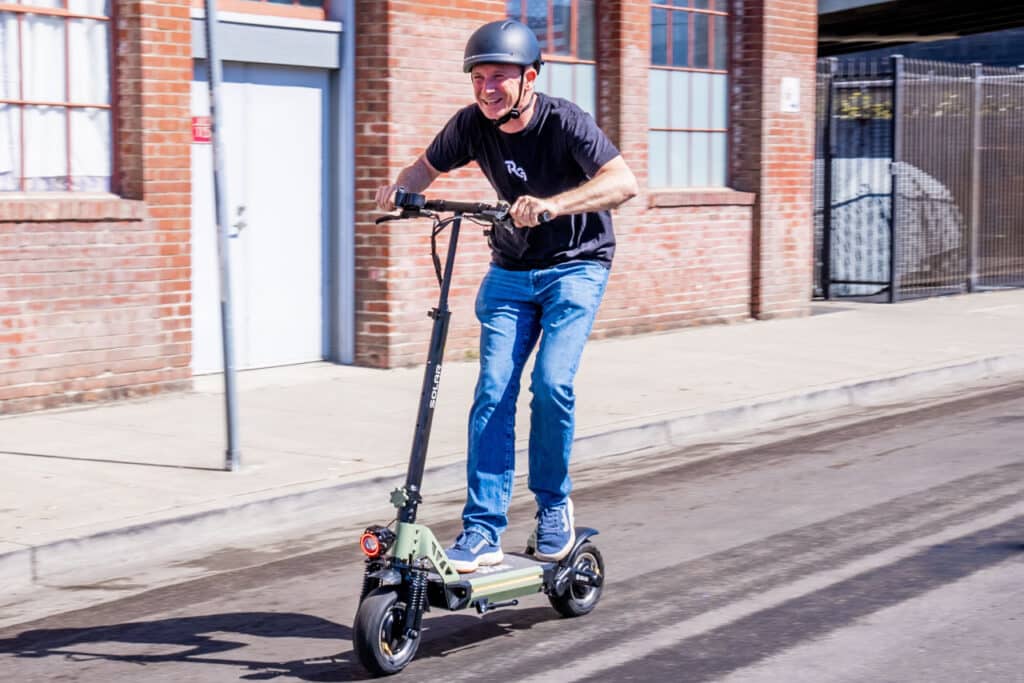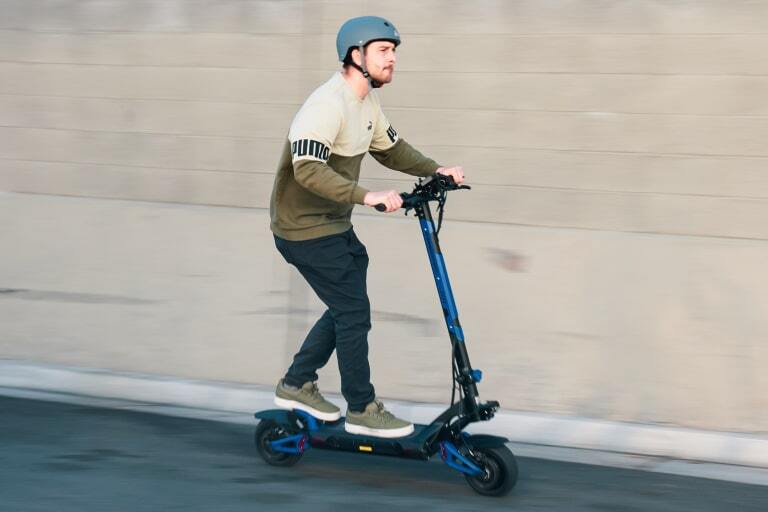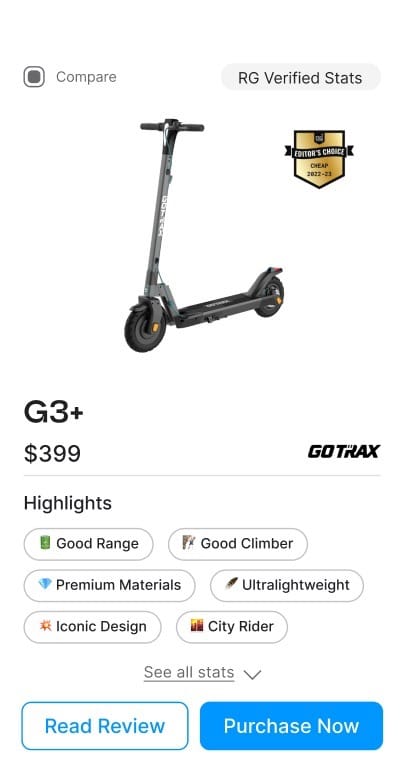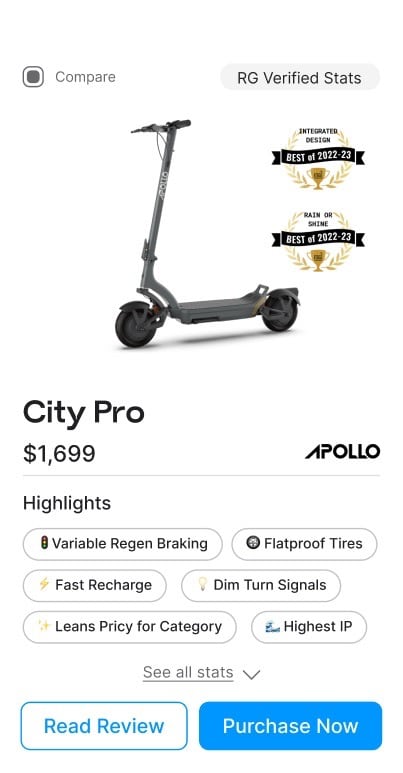This is the definitive guide to electric scooters. It is a starting point for all information about their history, different components, commuting, laws, safety, maintenance, and scooter sharing.
Not sure you’re in the right place? We have lots of other guides.
- To learn more about purchasing see our buying guide.
- To skip the research, check out our Editor’s Choice best electric scooters.
- Make in-depth technical and price comparisons.
- Compare real-world performance including range and hill climb tests.
Wait, Electric Scooters Aren’t Toys?

Electric kick scooters, like the Razor kick scooters of the 1990s, have two wheels, a platform called a deck, and handlebars for steering. They differ from the unmotorized kick scooters of the 90s due to the addition of a battery, electronics, larger (often air-filled) tires, and an electric motor.
Though the majority of scooters are intended to be ridden while standing on the deck, some scooters can be converted into seated electric scooters with optional accessories.
Recently, there has been an enormous surge in interest for scooters — mainly driven by their notorious overnight introduction into cities by scooter sharing companies such as Lime and Bird.
Scooter sharing has increased the general public awareness of micromobility and driven the growth of the personal market. The explosion of the personal market has led to the import of hundreds of different models of electric scooters by a huge number of different brands.
Though most companies are making electric scooters for adults, some companies — notably Razor — are targeting the kids and young teen market.
Electric Scooters For Adults
Adult electric scooters are the most common type of scooter available on the market. They differ from electric scooters intended for children because they have larger weight capacity, typically around 220 lbs (100 kg), more powerful motors, larger battery, larger deck, and a taller stem. Electric scooters intended for adults also tend to cost at least $300 whereas an electric scooter intended for children can typically be had for under $200.
Some popular brands of electric scooters for adults are: Boosted, Glion, GoTrax, Xiaomi, Swagtron, Zero, and Fluid FreeRide, Kaabo, and MiniMotors.
Some notable models are the Xiaomi Mi M365, Dualtron, Wide Wheel, Zero 10X, Boosted Rev and Wolf Warrior 11.
A typical adult scooter weighs under 30 lbs, has a 250-watt motor, a 250 watt-hour lithium-ion battery, has a top speed of 15 mph, a range of 10 miles, and costs around $500.
Electric Scooters For Kids

Electric scooters intended for kids or teens are typically smaller, lighter, and less expensive than their adult counterparts. They are often made of less durable materials such as plastic, have weak motors, and may even contain low energy density lead-acid batteries.
It is worth noting that children’s electric scooters aren’t typically much more than toys and should be used as such. They shouldn’t be used for riding on public roads or ridden by adults.
Some popular brands of electric scooters for kids are: Razor and Jetson.
A typical children’s electric scooter weighs around 20 lbs, has 150-watt motor, 100 watt-hour battery (either sealed lead acid or lithium-ion), a range of 3 miles, and costs around $200.
Note: Larger or taller teens should use an adult electric scooter because a kids scooter will likely be too small and underpowered.
Seated Electric Scooters
Seated electric scooters are primarily for adults and made to make longer rides more comfortable. Most electric scooters do not come with a seat, but many have optional seat attachments that are sold as separate accessories.
A hallmark of the modern e-scooter is its ability to fold — making it both portable for carrying and convenient for storing. This is the main advantage of folding electric scooters, compared to electric bicycles. When a seat is added to an electric scooter, this typically eliminates its folding ability and, in our eyes, reduces many of the advantages of folding e-scooters.
If you have a need for a scooter with a seat, then you might consider an electric bicycle instead. Electric bicycles are typically easier to ride, faster, and more comfortable for longer distances. You can’t fold them up for easier carrying — but neither can you fold a seated electric scooter.
Breakdown (of All of the Parts) of an Electric Scooter
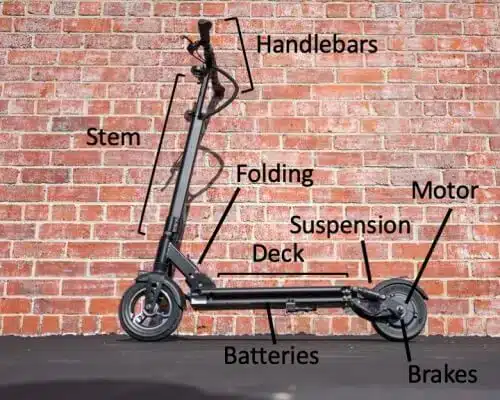
Electric Scooter Parts
Electric scooters have a handful of different parts, but the major ones are: batteries, brakes, controller, deck, handlebars, lights, motor, stem, suspension, and tires.
Batteries

Electric scooter battery packs are made up of many individual cells that are assembled together.
Batteries are the “gas tank” of an electric scooter. They store the energy that is consumed by the electric motor and other accessories, including lights.
Most electric scooters will have a battery pack comprised of lithium-ion battery cells, though some electric scooters for kids and other inexpensive scooters actually have lead-acid batteries.
Batteries are rated in watt-hours, abbreviated Wh, which is a measure of their capacity. Battery capacity is one of the important factors that determine electric scooter range. A typical budget scooter will have a capacity of around 250 watt-hours while monster scooters can have capacities of almost 3,000 watt-hours.
Learn more: technical guide to electric scooter batteries.
Brakes
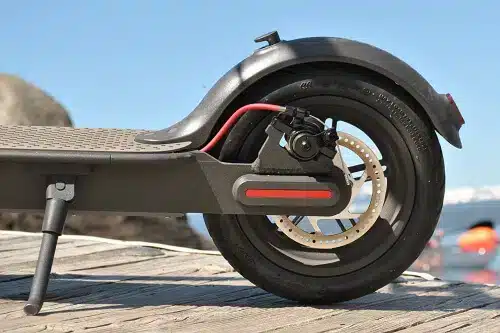
A quality braking system, such as the disc brake picture above, is essential for staying safe and in control while riding an electric scooter.
Like those on a car or bicycle, brakes are what slow the electric scooter down. Electric scooter brakes can be broken down into two categories: mechanical and electronic.
Mechanical brake systems are those that rely on a physical mechanism to slow the scooter down and are: disc, drum, and foot brakes.
Electronic braking systems rely on using the motor itself for braking and include strictly electronic and regenerative braking systems.
Typically mechanical braking systems will offer much stronger braking than electronic systems. However, electronic systems benefit from not requiring any periodic adjustments or maintenance.
Many scooters will have a combination of both electronic and mechanical braking systems. For safety reasons, we recommend scooters that have at least two braking systems in case one fails.
Learn more about brakes: a technical guide to brakes.
Controller

The speed controller sends power to the motor based on accelerator input.
The speed controller is an electronic component buried deep inside of the scooter that controls the flow of current from the battery to the motor. They typically look like rectangular metal cans with many wires coming out of them. The metal enclosure serves as a heat sync. The controller receives inputs from the accelerator and (electronic) brake controls and translates that into a current that is sent to the motor.
Controllers are rated based on the voltage and current they are able to regulate. Scooters with more powerful motors will have controllers with higher max voltage and higher max current ratings.
Controllers are one of the most under-appreciated parts of the electric scooter because they quietly do their job most of the time. They can be a huge source of headache (or make the scooter unsafe) when things go wrong. On some poorly designed scooters controllers are known to fail or malfunction.
Deck

The deck is the platform you stand on while riding. Many are rubberized to provide better traction.
The electric scooter deck — like that of a skateboard — is the thing you stand on. Some electric kick scooters have the battery pack built into the deck.
Most decks have some type of textured finish that provides better grip between your shoes and the scooter. Some scooters, like the Rev pictured above, have a sloped deck that gives you more space to place your feet.
The typical scooter deck size is 14″ by 5″ inches and gives a few inches of ground clearance.
Handlebars
The handlebars are your main connection with the scooter. They are fitted with all the controls, including the accelerator, brakes, speed/settings display, and power buttons.
The most portable electric scooters will have folding handlebars that greatly reduce their width and get the scooter down to a very transportable and storable size.
Lights

Good scooter lighting is important for seeing and staying visible at night. Unfortunately, many of the scooters we test have lackluster built-in lighting.
Nearly every electric scooter comes with at least one LED headlight and a brake-activated tail light. Additionally, many scooters are also including multi-colored LEDs that wrap around or shine from under the deck. We like to call this type of lighting swag lighting.
Swag and deck lighting are good for increasing visibility and cool factor of your scooter, but no substitute for powerful headlight and taillights.
Unfortunately, many electric scooters have sorrowfully weak lights. This is why we nearly always recommend additional lighting for safely riding at night.
Motor

Adult electric scooters have hub motors built into one or both wheels. The powerhouse Wide Wheel pictured above has dual 500-watt motors.
Electric scooters have brushless direct current (BLDC) electric motors that are built into the hub of wheels. All electric kick scooters have at least one motor while more powerful ones will have two.
Electric motors are rated based on their power consumption which is express in units of watts. More powerful motors will have greater wattage.
An average electric scooter, like the Mi M365 will have a 250 watt motor; an intermediate scooter like the Horizon will have a 500 watt motor; extreme performance scooters, like the Wolf Warrior will have dual 1200 watt motors.
See our technical guide to electric scooter motors.
Stem

The stem is the folding metal tube that connects that handlebars to the front wheels. On some electric scooters the folding mechanism is a source of frustration due to instability.
The stem or neck of the electric scooter is the long tube that is connected to the front wheel and extends up to the handlebars.
Nearly every scooter has a folding mechanism built into the stem to allow easy carrying and storage. In our e-scooter reviews, we often spend a lot of time focusing on this unsuspecting part. Yet, this is for good reason. The folding mechanism can be difficult work or worse it can be loose or unstable. When you apply force to the handlebars, you’ll notice the whole stem rocking back and fourth — a condition we call stem wobble. This is one of the huge downsides to folding electric scooters.
Unfortunately, its not just the low-end scooters that suffer from poor stem folding mechanisms. The high-end Dualtron scooters are notorious for this issue, despite their otherwise immense quality.
Suspension
Many electric scooters have no suspension, while high performance ones, like the Zero 8X pictured above feature a beefy coil-over-hydraulic suspension.
The suspension of the electric scooter, like that on motor vehicle or bicycle, helps to improve ride quality and dampin bumps in the road.
There are three main types of suspension systems that are typically found on electric scooters: spring, hydraulic or air piston, and rubber suspension. Scooters with the best suspension will have some combination of spring and piston — a combination called coil-over-hydraulic or coil-over-air.
Many scooters forgo suspension in favor of large pneumatic tires that provide damping effects. Large pneumatic tires can offer be a better form of suspension that cheap spring suspensions.
Tires

Tires given you traction to accelerate or brake in an emergency. Airless tires, like those pictured above, do not perform as well as pneumatic tires.
Tires are your connection to the road and influence ride quality, traction, range, and braking performance of your electric kick scooter.
Tires come in basically two types: pneumatic (airfilled) and airless. There are a few varieties of airless tires and these include: honeycomb, polymer-filled, and solid.
We always recommend pneumatic tires because they give better ride quality (with or without suspension) and their supple rubber performs much better in adverse road conditions.
For deeper dive into scooter tires, read our technical guide.
Researching an Electric Scooter for You
Purchasing an electric scooter can be a formidable challenge — there are an overwhelming number of choices, a quality electric scooter is easily $500 and can cost upwards of $2,000.
Throwing a wrench into the matters are numerous dubious “review” sites and reviewers that have never touched a scooter in their life.
We have personally tested and developed unbiased written and video reviews for electric scooters at all price ranges, so that you can find the one that best fits your needs.
- To buy a scooter without research, you pick one from our curated Best Electric Scooters list. We also have articles on top-rated scooters at the $300, $600, $900, $1200, $1600, and $2500 price ranges.
- For a deeper education, start with our guide to buying an electric scooter.
Commuting Considerations with an Electric Scooter
Commuting by electric scooter is all part of the new trend in micromobility that solves the so-called last mile problem. The last mile problem refers to the last leg of a trip — whether it be walking from bus station to your office or exiting a freeway in a car to go to a specific destination.
Paradoxically, the leg of a trip tends to be the slowest and most difficult despite being the shortest. This is because public transit systems and roadways are all optimized for connecting big population centers separated by larger distances. Think about it — multilane highways connect major cities separate by tens or hundreds of miles. At average freeway speeds, you can go 60 miles in an hour or about a mile a minute.
However, once you’ve exited the freeway, your last mile or so could take 15 minutes or more!
This is where electric scooters, bike sharing, electric skateboards, etc — all forms of micro-mobility — come into play. They make traveling the last mile of your trip faster, easier, and more environmentally friendly.
If you have to commute just a few miles to work or have to walk from a bus stop or transit center, then an electric scooter is the perfect option for you.
Comparing Electric Scooters and Bicycles
Compared to bicycles, electric scooters are more portable, less prone to theft, and require less physical effort than a bicycle.
They allow you to get to your destination at speeds around 15 mph with no physical effort. You can arrive at your destination more quickly, fold up the scooter, and carry it inside. Because they require less physical effort than powering a bicycle, you won’t be as sweaty as you would if you were to ride a bike (and can get there faster on many scooters).
Electric scooters also have some disadvantages which might make bicycles a better option in some cases. These are: ability to bring inside, stability and cost.
If you aren’t physically able or not allowed to bring your electric scooter inside then a bicycle may be better. Locking an electric scooter up on the street for a prolonged period of time is not optimal — they seem to be more prone to theft, vandalism and are more difficult to lock due to lack of locking points.
Bicycles, due to their geometry and larger tires, are more stable and better on rough roads. Adult scooters have relatively small tires that do not roll over bumps easily. They also have a more upright steering angle which makes them inherently less stable and more prone to wobbles that have sent many a scooter rider down.
Finally, adult electric scooters are more expensive than a quality entry-level bicycle. An entry-level bicycle will run you around $300 and be much more durable. Crashing on a bicycle is unlikely to harm most whereas many scooters, particularly budget ones, can be rendered completely inoperable after a crash.
Electric Scooter Laws and Where You Can Ride
You should always review your local and state laws before riding an adult electric scooter on roads or in public areas. The information provided here regarding laws should not be taken as legal advice.
Laws for electric scooters vary a lot by state and city. In some jurisdictions, motorized electric scooters are completely prohibited.
In general, where they are legal, most jurisdictions are starting to regulate them in the same manner as bicycles. They generally must be ridden on the street or in bike lanes and are forbidden from riding on the sidewalk or pedestrian pathways.
Like a bicycle, you must obey all traffic laws that cars must adhere to. This includes stopping at stop signs and red lights.
Here’s our blog on electric scooter laws.
Why Wearing Gear When Riding Electric Scooters Is Important

Safety is no joke — you could be killed or permanently maimed riding an electric scooter.
Safety equipment including a helmet is an absolute necessity when riding the electric scooter at any speed. Depending on the speed and type of riding conditions that you experience, you may need more or less equipment.
Learn more about what type of helmet you should wear in our guide to electric scooter helmets.
Safety equipment that can prevent accidents and mitigate injuries includes:
- Helmet
- Gloves
- Knee pads
- Elbow pads
- Protective jacket and pants
- Lights
- Horn
For more information see our articles on electric scooter safety.
The NTA-8776 is an electric bicycle helmet standard that is more rigorous than any of the bicycle, downhill, or BMX standards.
Where You Can Get Your Electric Scooter Repaired
Electric scooters require no regular upkeep except checking pressure if they have pneumatic (air-filled) tires.
If you are looking for repair, maintenance or upgrade information, check out our detailed guides for different electric scooters (more are being added all the time).
Learn where you can get an electric scooter repair.
Related Reviews
